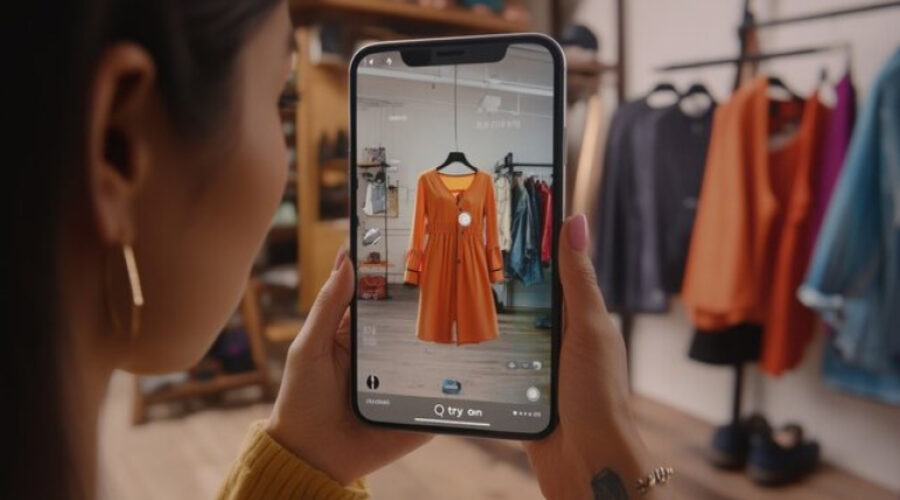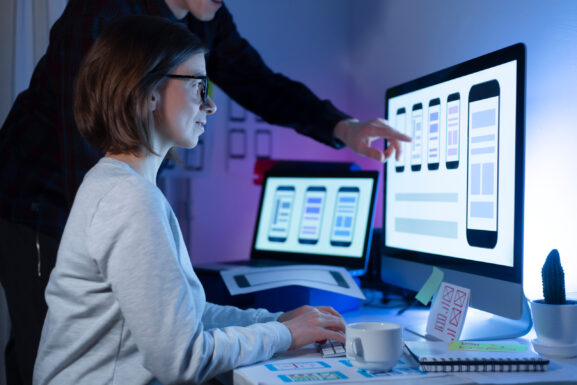Step-by-Step Guide: How to Create an Augmented Reality App
As a result, everyone is discussing the importance and advantages of augmented reality for your company. Your opponents have already been utilising the augmented revolution for a while. Do you feel as though your company is missing out on something?
How does augmented reality work:
Our technology-assisted perspective of the real world is simply covered with a layer of artificial objects and additional information known as augmented reality. By providing fresh layers of data to a smart gadget, it enriches the real world rather than removing you from it. In other words, augmented reality is a combination of the real world and virtual reality. However, do not be misled; it is not the same as muddled reality. We have discussed the distinctions between MR, VR, and AR. The information provided by AR is unique and pertinent to what you are doing or where you are right now.
So how does it function? Software on an AR-capable device can identify a sign, object, or image and add pertinent content so that we can see these layered visualisations as though they were real.
AR apps come in a wide variety — from straightforward text-notification apps to intricate surgical procedure instructions. They draw attention to crucial details, deepen comprehension, and offer timely and comprehensible information.
It achieves its main objective of bringing artificial items into the actual environment by projecting images onto a set of goggles, lenses, or a camera view.
How to create an AR application:
Starting with a new technology might be scary. But learning a new skill is simple to master if you break the knowledge down into manageable bits and take tiny, regular steps. Here are a few things to think about when developing AR apps.
1.Find a fantastic concept to improve your company. A smart strategy for handling it is competitor analysis.
2.Investigate the market for available platforms and SDKs for augmented reality development.
3. Choose the one that best fits your idea, budget, and level of skill. Platforms like Vuforia, Wikitude, and ARToolKit, for instance, demand a thorough understanding of C++, Java, or C#. Choose a simpler solution if programming languages aren’t your thing; for starters, Blippar or Aurasma are great options.
4.Keep in mind that 3D items are typically required for AR to work. You can either learn how to make them yourself or download pre-made models.
5.Make a 2D tracker, or a specific image that can be projected on a surface and read by AR-enabled hardware.
6.Create a distinctive design and gather all the 3D models, images, text files, and data that are required.
7.Combine all the components on the platform of your choice.
Best tools for building an augmented reality apps:
Selecting the proper software development kit (SDK) is essential if you want to try your hand at developing augmented reality applications. We have selected three of the most widely regarded augmented reality platforms from a wide range of options: Vuforia, Kudan AR, and Wikitude. Let’s investigate their powers.
Vuforia:
Vuforia is one of the most well-known SDKs available for AR creation today. It has currently run 35,000 apps.
Supports iOS, Android, UWP, and Unity Editor.
Both free and paid licences are available. The free version places a watermark on the final product and has restrictions on cloud identification.
Languages for programming offers API in C++, Java, Objective-C++, and.Net via a Unity game engine addon.
Real object, text, environment, and image recognition are features that are available. Target tracking mapping of additional items with OpenGL is another feature. Virtual buttons
Features: A test app with comments demonstrating Vuforia features is included, along with compatibility for virtual reality devices.
Limitations: Doesn’t have a thorough framework manual. Random instructions and brief advice are provided, but they cannot take the place of the necessary documents.
Kudan AR
This platform supports iOS, Android, and Unity.
Both free and paid licences are available.
C and C++ are programming languages.
Additional elements can be mapped using image recognition based on user location and recognised photos, among other features.
marking-free tracking (instead of fiducial markers, it relies on the use of natural features like edges, corners, or textures) using a separate component to map additional elements over OpenGL
Capabilities: It uses less storage space in a device because it can recognise a limitless amount of images.
Limitations:
Poor development documentation
No direct OpenGL access.
Augmented Reality App Development:
The creation of 3D models and the implementation of the algorithms used to superimpose virtual material over real-world scenes are the main concerns in the development of augmented reality apps. ScienceSoft creates top-notch AR software and has 26 years of experience in 3D modelling and 16 years in augmented reality.
Advertising AR apps:
AR enables you to develop marketing plans that leave a lasting impression on the audience. Install interactive AR screens in well-known areas to increase brand recognition, combine real-time live streaming with your sponsorship materials, or go above and beyond by coming up with a unique idea for AR advertising!
Manufacturing AR apps
For industrial engineers and personnel, augmented reality (AR) apps improve process because they enable them to prototype and construct complicated new machinery and equipment using digital representations of physical assets. Because there are fewer product redesign cycles and speedier personnel training and performance thanks to these lifelike simulations, production expenses are reduced.
AR-powered auto dashboards
Data gathered from sensors and cameras positioned inside and outside of automobiles is captured and visualised using augmented reality dashboards. This improves driving safety by alerting drivers immediately to danger indications (such as the presence of people or animals on the road, deteriorating weather or road conditions, and vehicle damage).
Augmented reality devices
Recognizing the many types of augmented reality (AR) devices
Despite the fact that the phrase “augmented reality” is relatively new, the earliest technological advancements may be found in the 1900s. The collimating reflector is a mechanism that Irish telescope maker Howard Grub patented. Its primary goal was to improve shooting accuracy by focusing the crosshair view precisely on the user’s intended target. The human eye’s limited ability to focus on more than one item at once was a crucial problem that it attempted to address. The creation of several military gun sights was influenced by Grubb’s idea.
Augmented reality devices can be broadly categorised into four types
Head up displays (HUD):
Pilots’ information processing requirements expanded with the quantity of sensors, avionics, and flight controls as onboard controllers on aircraft became more complicated. Instead of focusing on the vast amount of information within the cockpit, pilots must pay attention to what is happening outside. Mission-critical dashboards for weapons systems and flight controllers were the primary uses for heads-up displays. Transparent panels installed in front of the pilot are displayed with important information. Rather than gazing down within the cockpit, this permits pilots to look forward outside. HUDs attempted to address the issue of shifting focus by utilising a kind of collimating projector, similar to Grub’s collimating reflector.
Helmet mounted displays
Moving heads-up displays from the windshield to the helmet was the logical next step. In the aviation and other industries, helmet mounted displays that operate on the same fundamental principles as heads up displays are becoming more and more common.
Holographic displays
These types of displays, made popular in recent years by the Star Wars, Minority Report, and Iron Man series, use light diffraction to create three-dimensional representations of objects in actual space. One of the biggest benefits of holographic displays is that no special equipment is needed to observe them. These kinds of displays have always been associated with science fiction, but they have just recently begun to acquire popularity because of items like Looking Glass and Holovect.
Smart glasses
Smart glasses have become one of the more widely used varieties of augmented reality devices as the technology has evolved from critical applications in defence and aviation to commercially available products. These glasses let you see better, as their name implies.
Conclusion
Apps for augmented reality are getting more popular and widely available today.
Avoid being the last to reap the rewards. Making an app is not a mysterious art. Think creatively about how augmented reality technology could benefit your company.



